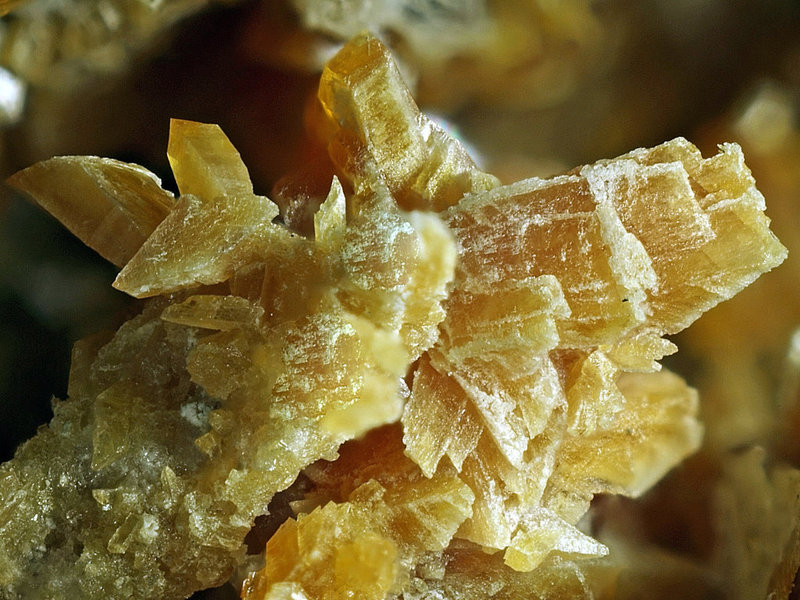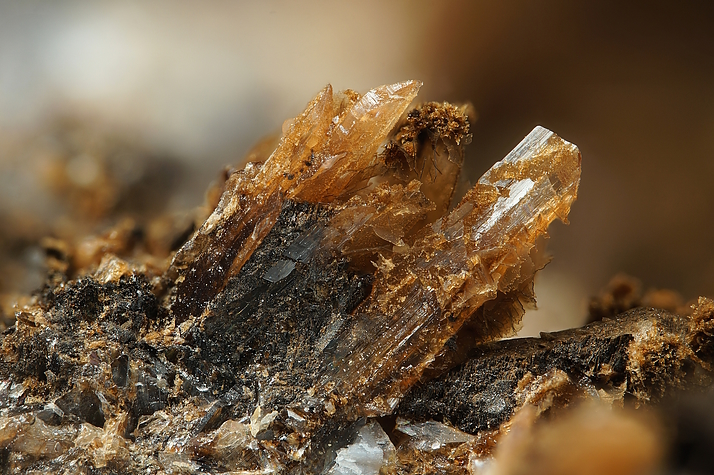Marsturite
A valid IMA mineral species
This page is currently not sponsored. Click here to sponsor this page.
About Marsturite
Formula:
NaCaMn3Si5O14(OH)
Colour:
Tan, white to very light pink
Hardness:
6
Specific Gravity:
3.46
Crystal System:
Triclinic
Name:
Named in 1978 by Donald Peacor and Pete Dunn in honor of Marion Butler Stuart [December 21, 1921 - July 26, 2000 Hailey, Idaho, USA], of Bellevue, Idaho, USA, amateur mineral collector and benefactor of mineralogical projects.
Type Locality:
Isostructural with:
Unique Identifiers
Mindat ID:
2581
Long-form identifier:
mindat:1:1:2581:8
GUID
(UUID V4):
(UUID V4):
5b158d83-b1aa-4ca1-9377-daa9f72993ec
IMA Classification of Marsturite
Approved
IMA Formula:
NaCaMn2+3Si5O14(OH)
Classification of Marsturite
9.DK.05
9 : SILICATES (Germanates)
D : Inosilicates
K : Inosilicates with 5-periodic single chains
9 : SILICATES (Germanates)
D : Inosilicates
K : Inosilicates with 5-periodic single chains
65.4.1.6
65 : INOSILICATES Single-Width,Unbranched Chains,(W=1)
4 : Single-Width Unbranched Chains, W=1 with chains P=5
65 : INOSILICATES Single-Width,Unbranched Chains,(W=1)
4 : Single-Width Unbranched Chains, W=1 with chains P=5
14.18.29
14 : Silicates not Containing Aluminum
18 : Silicates of Mn and Na, K, Mg, Ca or Fe
14 : Silicates not Containing Aluminum
18 : Silicates of Mn and Na, K, Mg, Ca or Fe
Mineral Symbols
As of 2021 there are now IMA–CNMNC approved mineral symbols (abbreviations) for each mineral species, useful for tables and diagrams.
| Symbol | Source | Reference |
|---|---|---|
| Msr | IMA–CNMNC | Warr, L.N. (2021). IMA–CNMNC approved mineral symbols. Mineralogical Magazine, 85(3), 291-320. doi:10.1180/mgm.2021.43 |
Physical Properties of Marsturite
Transparency:
Transparent, Translucent
Colour:
Tan, white to very light pink
Hardness:
6 on Mohs scale
Cleavage:
Imperfect/Fair
{100} and {001}
{100} and {001}
Density:
3.46 g/cm3 (Measured) 3.465 g/cm3 (Calculated)
Optical Data of Marsturite
Type:
Biaxial (+)
RI values:
nα = 1.686(2) nβ = 1.691(1) nγ = 1.708(1)
2V:
Measured: 60° (1), Calculated: 58°
Max Birefringence:
δ = 0.022

Image shows birefringence interference colour range (at 30µm thickness)
and does not take into account mineral colouration.
and does not take into account mineral colouration.
Surface Relief:
High
Dispersion:
r > v weak
Chemistry of Marsturite
Mindat Formula:
NaCaMn3Si5O14(OH)
Common Impurities:
Fe,Mg
Crystallography of Marsturite
Crystal System:
Triclinic
Class (H-M):
1 - Pinacoidal
Space Group:
P1
Cell Parameters:
a = 7.70 Å, b = 12.03 Å, c = 6.78 Å
α = 85.26°, β = 94.1°, γ = 111.04°
α = 85.26°, β = 94.1°, γ = 111.04°
Ratio:
a:b:c = 0.64 : 1 : 0.564
Unit Cell V:
583.57 ų (Calculated from Unit Cell)
Comment:
Nagashima et al. (2014) give 7.697(2), 11.720(2), 6.771(1) Å, 92.40(3), 94.41(3), 106.83(3), V = 581.9(6) Å3 for a sample from the Molinello mine.
Crystal Structure
Load
Unit Cell | Unit Cell Packed
2x2x2 | 3x3x3 | 4x4x4
Unit Cell | Unit Cell Packed
2x2x2 | 3x3x3 | 4x4x4
Show
Big Balls | Small Balls | Just Balls | Spacefill
Polyhedra Off | Si Polyhedra | All Polyhedra
Remove metal-metal sticks
Big Balls | Small Balls | Just Balls | Spacefill
Polyhedra Off | Si Polyhedra | All Polyhedra
Remove metal-metal sticks
Display Options
Black Background | White Background
Perspective On | Perspective Off
2D | Stereo | Red-Blue | Red-Cyan
Black Background | White Background
Perspective On | Perspective Off
2D | Stereo | Red-Blue | Red-Cyan
View
CIF File Best | x | y | z | a | b | c
CIF File Best | x | y | z | a | b | c
Rotation
Stop | Start
Stop | Start
Labels
Console Off | On | Grey | Yellow
Console Off | On | Grey | Yellow
Data courtesy of the American Mineralogist Crystal Structure Database. Click on an AMCSD ID to view structure
| ID | Species | Reference | Link | Year | Locality | Pressure (GPa) | Temp (K) |
|---|---|---|---|---|---|---|---|
| 0020225 | Marsturite | Nagashima M, Armbruster T, Kolitsch U, Pettke T (2014) The relation between Li <-> Na substitution and hydrogen bonding in five-periodic single-chain silicates nambulite and marsturite: A single-crystal X-ray study American Mineralogist 99 1462-1470 | 2014 | Molinello mine, Liguria, Italy | 0 | 293 |
CIF Raw Data - click here to close
Epitaxial Relationships of Marsturite
Epitaxial Minerals:
| Rhodonite | CaMn3Mn[Si5O15] |
Epitaxy Comments:
Marsturite very frequently occurs grown epitaxially on bladed rhodonite crystals (Franklin, NJ).
Geological Environment
Paragenetic Mode(s):
| Paragenetic Mode | Earliest Age (Ga) |
|---|---|
| High-𝑇 alteration and/or metamorphism | |
| 32 : Ba/Mn/Pb/Zn deposits, including metamorphic deposits | |
| Stage 4b: Highly evolved igneous rocks | >3.0 |
| 34 : Complex granite pegmatites |
Type Occurrence of Marsturite
General Appearance of Type Material:
euhedral, prismatic crystals up to 0.5 mm in size
Place of Conservation of Type Material:
National Museum of Natural History, Smithsonian Institution, under catalog #127923
Geological Setting of Type Material:
As a secondary mineral in cavities in fractures traversing massive -franklinite-willemite-zincite ore in a Precambrian Zn-Mn-Fe orebody hosted in the Franklin marble.
Associated Minerals at Type Locality:
Reference:
Peacor, D. R., Dunn, P. J., & Sturman, B. D. (1978). Marsturite, Mn 3 CaNaHSi 5 O 15, a new mineral of the nambulite group from Franklin, New Jersey. American Mineralogist, 63(11-12), 1187-1189.
Synonyms of Marsturite
Other Language Names for Marsturite
German:Marsturit
Spanish:Marsturita
Common Associates
Associated Minerals Based on Photo Data:
| 14 photos of Marsturite associated with Rhodonite | CaMn3Mn[Si5O15] |
| 10 photos of Marsturite associated with Axinite-(Mn) | Ca2Mn2+Al2BSi4O15(OH) |
| 6 photos of Marsturite associated with Ganophyllite | (K,Na,Ca)2Mn8(Si,Al)12(O,OH)32 · 8H2O |
| 5 photos of Marsturite associated with Cahnite | Ca2[B(OH)4](AsO4) |
| 5 photos of Marsturite associated with Willemite | Zn2SiO4 |
| 1 photo of Marsturite associated with Rhodochrosite | MnCO3 |
Related Minerals - Strunz-mindat Grouping
| 9.DK. | Ferrorhodonite | CaMn3Fe[Si5O15] |
| 9.DK. | Vittinkiite | MnMn3Mn[Si5O15] |
| 9.DK. | Ferri-hellandite-(Ce) | (Ca3Ce)Ce2Fe3+◻2B4Si4O22(OH)2 |
| 9.DK. | Shijiangshanite | Pb3CaAl(Si5O14)(OH)3 · 3H2O |
| 9.DK.05 | Allagite | |
| 9.DK.05 | Babingtonite | Ca2(Fe,Mn)FeSi5O14(OH) |
| 9.DK.05 | Lithiomarsturite | LiCaMn3Si5O14(OH) |
| 9.DK.05 | Manganbabingtonite | Ca2(Mn,Fe)FeSi5O14(OH) |
| 9.DK.05 | Nambulite | LiMn2+4Si5O14(OH) |
| 9.DK.05 | Natronambulite | (Na,Li)(Mn,Ca)4Si5O14OH |
| 9.DK.05 | Rhodonite | CaMn3Mn[Si5O15] |
| 9.DK.05 | Scandiobabingtonite | Ca2(Fe2+,Mn)ScSi5O14(OH) |
| 9.DK.10 | Santaclaraite | CaMn4[Si5O14OH](OH) · H2O |
| 9.DK.15 | Saneroite | NaMn2+5[Si5O14(OH)](VO3)(OH) |
| 9.DK.20 | Hellandite-(Y) | (Ca,REE)4Y2Al◻2(B4Si4O22) (OH)2 |
| 9.DK.20 | Tadzhikite-(Ce) | Ca4Ce3+2Ti◻2(B4Si4O22)(OH)2 |
| 9.DK.20 | Hellandite-(Yb) | (Ca,Y)4(Yb,Y)2(Al,Fe3+,Ti4+)(Be,Li)2[B4Si4O22](O,F,OH)2 |
| 9.DK.20 | Mottanaite-(Ce) | Ca4(Ce,REE)Σ2Al(Be1.5◻0.5)Σ2[B4Si4O22]O2 |
| 9.DK.20 | Ciprianiite | Ca4[(Th,U),Ca]Σ2Al(Be0.5◻1.5)Σ2[B4Si4O22](OH)2 |
| 9.DK.20 | Hellandite-(Ce) | (Ca,REE)4Ce2Al◻2(B4Si4O22) (OH)2 |
| 9.DK.20 | Ferri-mottanaite-(Ce) | Ca4Ce2Fe3+(Be1.5◻0.5)[Si4B4O22]O2 |
Fluorescence of Marsturite
None.
Other Information
Health Risks:
No information on health risks for this material has been entered into the database. You should always treat mineral specimens with care.
Internet Links for Marsturite
mindat.org URL:
https://www.mindat.org/min-2581.html
Please feel free to link to this page.
Please feel free to link to this page.
Search Engines:
External Links:
Mineral Dealers:
References for Marsturite
Reference List:
Peacor, Donald R., Dunn, Pete J., Sturman, B. Darko (1978) Marsturite, Mn3CaNaHSi5O15, a new mineral of the nambulite group from Franklin, New Jersey. American Mineralogist, 63 (11-12) 1187-1189
Localities for Marsturite
Locality List
 - This locality has map coordinates listed.
- This locality has map coordinates listed.
 - This locality has estimated coordinates.
ⓘ - Click for references and further information on this occurrence.
? - Indicates mineral may be doubtful at this locality.
- This locality has estimated coordinates.
ⓘ - Click for references and further information on this occurrence.
? - Indicates mineral may be doubtful at this locality.
 - Good crystals or important locality for species.
- Good crystals or important locality for species.
 - World class for species or very significant.
(TL) - Type Locality for a valid mineral species.
(FRL) - First Recorded Locality for everything else (eg varieties).
- World class for species or very significant.
(TL) - Type Locality for a valid mineral species.
(FRL) - First Recorded Locality for everything else (eg varieties).
All localities listed without proper references should be considered as questionable.
India | |
| Chakrabarty et al. (2018) |
Italy | |
| Mineralogical Record 32: 356 +4 other references |
| Hans van t Zelfde +1 other reference |
| Balestra et al. (2020) |
Japan | |
| Matsubara et al (1990) |
| www.issp.u-tokyo.ac.jp (n.d.) +4 other references |
Russia | |
| Aupova et al. (2001) |
| Joan Rosell-rosellminerals |
Spain | |
| Dill et al. (2023) |
USA (TL) | |
| Peacor et al. (1978) +2 other references |
Quick NavTopAbout MarsturiteUnique IdentifiersIMA Classification Classification Mineral SymbolsPhysical Properties Optical Data Chemistry Crystallography Crystal StructureEpitaxial Relationships Geological EnvironmentType Occurrence SynonymsOther LanguagesCommon AssociatesStrunz-MindatFluorescence Other InformationInternet Links References Localities Locality List






 symbol to view information about a locality.
The
symbol to view information about a locality.
The 




Molinello Mine, Ne, Genoa, Liguria, Italy